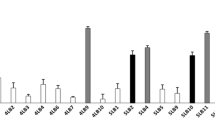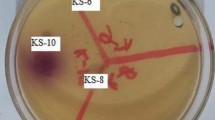Abstract
In this study, Lactobacillus crispatus UBLCp01, Lactobacillus gasseri UBLG36, and Lactobacillus johnsonii UBLJ01 isolated from the vagina of healthy reproductive age Indian women were screened for beneficial probiotic properties. These strains showed the ability to survive acidic and simulated vaginal fluid conditions and could adhere to mucin. Lact. gasseri UBLG36, and Lact. johnsonii UBLJ01 produced d- and l-lactic acid, whereas Lact. crispatus UBLCp01 produced hydrogen peroxide and d- and l-lactic acid. All strains inhibited the growth of pathogens (Escherichia coli, Gardnerella vaginalis, Proteus mirabilis, and Candida albicans) and were capable of co-aggregating with them with varying degrees. Strains secreted exopolysaccharides and formed biofilms under in vitro conditions. Safety assessment showed that these strains had a usual antibiotic susceptibility profile, did not produce hemolysins, gelatinases, and mucin degrading enzymes. Based on strain characteristics and beneficial properties, we believe that these strains are promising candidates for human trials to confirm their ability to prevent/treat vaginal dysbiosis and maintain a healthy vaginal eco-system.





Similar content being viewed by others
Data Availability
All data is included in the text; however, the raw data of this article will be made available by the authors, without undue reservation, to any qualified researcher.
References
Smith SB, Ravel J (2017) The vaginal microbiota, host defence and reproductive physiology. J Physiol 595:451–463. https://doi.org/10.1113/JP271694
Ravel J, Gajer P, Abdo Z, Schneider GM, Koenig SS, McCulle SL, Karlebach S, Gorle R, Russell J, Tacket CO, Brotman RM, Davis CC, Ault K, Peralta L, Forney LJ (2011) Vaginal microbiome of reproductive-age women. Proc Natl Acad Sci USA 108S1:4680–4687. https://doi.org/10.1073/pnas.1002611107
Amabebe E, Anumba DOC (2018) The vaginal microenvironment: the physiologic role of Lactobacilli. Front Med (Lausanne) 5:181. https://doi.org/10.3389/fmed.2018.00181
Macklaim JM, Fernandes AD, Di Bella JM, Hammond JA, Reid G, Gloor GB (2013) Comparative meta-RNA-seq of the vaginal microbiota and differential expression by Lactobacillus iners in health and dysbiosis. Microbiome 1:12. https://doi.org/10.1186/2049-2618-1-12
Stafford GP, Parker JL, Amabebe E, Kistler J, Reynolds S, Stern V, Paley M, Anumba DOC (2017) Spontaneous preterm birth is associated with differential expression of vaginal metabolites by Lactobacilli-dominated microflora. Front Physiol 8:615. https://doi.org/10.3389/fphys.2017.00615
Chee WJY, Chew SY, Than LTL (2020) Vaginal microbiota and the potential of Lactobacillus derivatives in maintaining vaginal health. Microb Cell Fact 19:203. https://doi.org/10.1186/s12934-020-01464-4
Song SD, Acharya KD, Zhu JE, Deveney CM, Walther-Antonio MRS, Tetel MJ, Chia N (2020) Daily vaginal microbiota fluctuations associated with natural hormonal cycle, contraceptives, diet, and exercise. mSphere 5:e00593-e620. https://doi.org/10.1128/mSphere.00593-20
Chen X, Lu Y, Chen T, Li R (2021) The female vaginal microbiome in health and bacterial vaginosis. Front Cell Infect Microbiol 11:631972. https://doi.org/10.3389/fcimb.2021.631972
Peebles K, Velloza J, Balkus JE, McClelland RS, Barnabas RV (2019) High global burden and costs of bacterial vaginosis: a systematic review and meta-analysis. Sex Transm Dis 46:304–311. https://doi.org/10.1097/OLQ.0000000000000972
Machado D, Castro J, Palmeira-de-Oliveira A, Martinez-de-Oliveira J, Cerca N (2016) Bacterial vaginosis biofilms: challenges to current therapies and emerging solutions. Front Microbiol 6:1528. https://doi.org/10.3389/fmicb.2015.01528
Jeng HS, Yan TR, Chen JY (2020) Treating vaginitis with probiotics in non-pregnant females: a systematic review and meta-analysis. Exp Ther Med 20:3749–3765. https://doi.org/10.3892/etm.2020.9090
Bohbot JM, Daraï E, Bretelle F, Brami G, Daniel C, Cardot JM (2018) Efficacy and safety of vaginally administered lyophilized Lactobacillus crispatus IP 174178 in the prevention of bacterial vaginosis recurrence. J Gynecol Obstet Hum Reprod 47:81–86. https://doi.org/10.1016/j.jogoh.2017.11.005
Geshnizgani AM, Onderdonk AB (1992) Defined medium simulating genital tract secretions for growth of vaginal microflora. J Clin Microbiol 30:1323–1326. https://doi.org/10.1128/JCM.30.5.1323-1326.1992
Pedersen C, Jonsson H, Lindberg JE, Roos S (2004) Microbiological characterization of wet wheat distillers’ grain, with focus on isolation of lactobacilli with potential as probiotics. Appl Environ Microbiol 70:1522–1527. https://doi.org/10.1128/aem.70.3.1522-1527.2004
Ahire JJ, Jakkamsetty C, Kashikar MS, Lakshmi SG, Madempudi RS (2021) In vitro evaluation of probiotic properties of Lactobacillus plantarum UBLP40 isolated from traditional indigenous fermented food. Probiotics Antimicrob Proteins. https://doi.org/10.1007/s12602-021-09775-7
Zhou JS, Gopal PK, Gill HS (2001) Potential probiotic lactic acid bacteria Lactobacillus rhamnosus (HN001), Lactobacillus acidophilus (HN017) and Bifidobacterium lactis (HN019) do not degrade gastric mucin in vitro. Int J Food Microbiol 63:81–90. https://doi.org/10.1016/s0168-1605(00)00398-6
Ahire JJ, Dicks LM (2014) 2,3-dihydroxybenzoic acid-containing nanofiber wound dressings inhibit biofilm formation by Pseudomonas aeruginosa. Antimicrob Agents Chemother 58:2098–2104. https://doi.org/10.1128/AAC.02397-13
Rosenberg M, Gutnick D, Rosenberg E (1980) Adherence of bacteria to hydrocarbons: a simple method for measuring cell-surface hydrophobicity. FEMS Microbiol Lett 9:29–33. https://doi.org/10.1111/j.1574-6968.1980.tb05599.x
Ahire JJ, Kashikar MS, Lakshmi SG, Madempudi R (2020) Identification and characterization of antimicrobial peptide produced by indigenously isolated Bacillus paralicheniformis UBBLi30 strain. 3 Biotech 10:112. https://doi.org/10.1007/s13205-020-2109-6
Del Re B, Sgorbati B, Miglioli M, Palenzona D (2000) Adhesion, autoaggregation and hydrophobicity of 13 strains of Bifidobacterium longum. Lett Appl Microbiol 31:438–442. https://doi.org/10.1046/j.1365-2672.2000.00845.x
Campana R, van Hemert S, Baffone W (2017) Strain-specific probiotic properties of lactic acid bacteria and their interference with human intestinal pathogens invasion. Gut Pathog 9:12. https://doi.org/10.1186/s13099-017-0162-4
Ahire JJ (2012) Studies on probiotic microorganism(s) and its biogenic metabolite(s). Ph.D. Dissertation, North Maharashtra University, India
Matuschek E, Brown DF, Kahlmeter G (2014) Development of the EUCAST disk diffusion antimicrobial susceptibility testing method and its implementation in routine microbiology laboratories. Clin Microbiol Infect 20:O255–O266. https://doi.org/10.1111/1469-0691.12373
Clinical and Laboratory Standards Institute (2020) Performance standards for antimicrobial susceptibility testing. 30th ed. CSLI supplement M100.Wayne, PA. https://clsi.org/media/3481/m100ed30_sample.Pdf
Andrews JM (2001) Determination of minimum inhibitory concentrations. J Antimicrob Chemother 48:5–16. https://doi.org/10.1093/jac/48.suppl_1.5
EFSA (2018) Guidance on the characterisation of microorganisms used as feed additives or as production organisms. EFSA J 16:e05206. https://doi.org/10.2903/j.efsa.2018.5206
Pino A, Bartolo E, Caggia C, Cianci A, Randazzo CL (2019) Detection of vaginal lactobacilli as probiotic candidates. Sci Rep 9:3355. https://doi.org/10.1038/s41598-019-40304-3
Stingele F, Neeser JR, Mollet B (1996) Identification and characterization of the eps (Exopolysaccharide) gene cluster from Streptococcus thermophilus Sfi6. J Bacteriol 178:1680–1690. https://doi.org/10.1128/jb.178.6.1680-1690.1996
Neveling DP, Ahire JJ, Laubscher W, Rautenbach M, Dicks LMT (2020) Genetic and phenotypic characteristics of a multi-strain probiotic for broilers. Curr Microbiol 77:369–387. https://doi.org/10.1007/s00284-019-01797-3
Ahire JJ, Dicks LM (2015) Nisin incorporated with 2,3-dihydroxybenzoic acid in nanofibers inhibits biofilm formation by a methicillin-resistant strain of Staphylococcus aureus. Probiotics Antimicrob Proteins 7:52–59. https://doi.org/10.1007/s12602-014-9171-5
López-Moreno A, Aguilera M (2021) Vaginal probiotics for reproductive health and related dysbiosis: systematic review and meta-analysis. J Clin Med 10:1461. https://doi.org/10.3390/jcm10071461
Massicotte R, Mafu AA, Ahmad D, Deshaies F, Pichette G, Belhumeur P (2017) Comparison between flow cytometry and traditional culture methods for efficacy assessment of six disinfectant agents against nosocomial bacterial species. Front Microbiol 8:112. https://doi.org/10.3389/fmicb.2017.00112
Pan M, Hidalgo-Cantabrana C, Goh YJ, Sanozky-Dawes R, Barrangou R (2020) Comparative analysis of Lactobacillus gasseri and Lactobacillus crispatus isolated from human urogenital and gastrointestinal tracts. Front Microbiol 10:3146. https://doi.org/10.3389/fmicb.2019.03146
Paavonen J (1983) Physiology and ecology of the vagina. Scand J Infect Dis Suppl 40:31–35
Tomás MSJ, Nader-Macías ME (2007) Effect of a medium simulating vaginal fluid on the growth and expression of beneficial characteristics of potentially probiotic lactobacilli. In: Mendez-Vilas A (ed) Communicating Current Research and Educational Topics and Trends in Applied Microbiology, 1st edn. Badajoz, Formatex, Spain, pp 732–739
Nader-Macías ME, Juárez Tomás MS (2015) Profiles and technological requirements of urogenital probiotics. Adv Drug Deliv Rev 92:84–104. https://doi.org/10.1016/j.addr.2015.03.016
Weerkamp AH, Uyen HM, Busscher HJ (1988) Effect of zeta potential and surface energy on bacterial adhesion to uncoated and saliva-coated human enamel and dentin. J Dental Res 67:1483–1487. https://doi.org/10.1177/00220345880670120801
Zeng Z, Zuo F, Marcotte H (2019) Putative adhesion factors in vaginal Lactobacillus gasseri DSM 14869: functional characterization. Appl Environ Microbiol 85:e00800-e819. https://doi.org/10.1128/AEM.00800-19
He Y, Niu X, Wang B, Na R, Xiao B, Yang H (2020) Evaluation of the inhibitory effects of Lactobacillus gasseri and Lactobacillus crispatus on the adhesion of seven common lower genital tract infection-causing pathogens to vaginal epithelial cells. Front Med (Lausanne) 7:284. https://doi.org/10.3389/fmed.2020.00284
Ocaña VS, Nader-Macías ME (2002) Vaginal lactobacilli: self- and co-aggregating ability. Br J Biomed Sci 59:183–190. https://doi.org/10.1080/09674845.2002.11783657
Tachedjian G, Aldunate M, Bradshaw CS, Cone RA (2017) The role of lactic acid production by probiotic Lactobacillus species in vaginal health. Res Microbiol 168:782–792. https://doi.org/10.1016/j.resmic.2017.04.001
Nasioudis D, Beghini J, Bongiovanni AM, Giraldo PC, Linhares IM, Witkin SS (2015) α-Amylase in vaginal fluid: association with conditions favorable to dominance of Lactobacillus. Reprod Sci 22:1393–1398. https://doi.org/10.1177/1933719115581000
O’Hanlon DE, Moench TR, Cone RA (2011) In vaginal fluid, bacteria associated with bacterial vaginosis can be suppressed with lactic acid but not hydrogen peroxide. BMC Infect Dis 11:200. https://doi.org/10.1186/1471-2334-11-200
Scillato M, Spitale A, Mongelli G, Privitera GF, Mangano K, Cianci A, Stefani S, Santagati M (2021) Antimicrobial properties of Lactobacillus cell-free supernatants against multidrug-resistant urogenital pathogens. MicrobiologyOpen 10:e1173. https://doi.org/10.1002/mbo3.1173
Terraf MC, Juárez Tomás MS, Nader-Macías ME, Silva C (2012) Screening of biofilm formation by beneficial vaginal lactobacilli and influence of culture media components. J Appl Microbiol 113:1517–1529. https://doi.org/10.1111/j.1365-2672.2012.05429.x
Verstraelen H, Verhelst R, Claeys G, De Backer E, Temmerman M, Vaneechoutte M (2009) Longitudinal analysis of the vaginal microflora in pregnancy suggests that L. crispatus promotes the stability of the normal vaginal microflora and that L. gasseri and/or L. iners are more conducive to the occurrence of abnormal vaginal microflora. BMC Microbiol 9:116. https://doi.org/10.1186/1471-2180-9-116
Angelin J, Kavitha M (2020) Exopolysaccharides from probiotic bacteria and their health potential. Int J Biol Macromol 162:853–865. https://doi.org/10.1016/j.ijbiomac.2020.06.190
Donnarumma G, Molinaro A, Cimini D, De Castro C, Valli V, De Gregorio V, De Rosa M, Schiraldi C (2014) Lactobacillus crispatus L1: high cell density cultivation and exopolysaccharide structure characterization to highlight potentially beneficial effects against vaginal pathogens. BMC Microbiol 14:137. https://doi.org/10.1186/1471-2180-14-137
Li T, Teng D, Mao R, Hao Y, Wang X, Wang J (2020) A critical review of antibiotic resistance in probiotic bacteria. Food Res Int 19:109571. https://doi.org/10.1016/j.foodres.2020.109571
Sirichoat A, Flórez AB, Vázquez L, Buppasiri P, Panya M, Lulitanond V, Mayo B (2020) Antibiotic susceptibility profiles of lactic acid bacteria from the human vagina and genetic basis of acquired resistances. Int J Mol Sci 21:2594. https://doi.org/10.3390/ijms21072594
Funding
This work was supported by Unique Biotech Limited, Hyderabad, India.
Author information
Authors and Affiliations
Contributions
Ahire JJ, Lakshmi SG, and Madempudi RS contributed to the study conception, Ahire JJ design the study. Material preparation, data collection, and analysis were performed by Ahire JJ, Kashikar MS, Sahoo S. Heerekar A re-confirmed the strains by DNA analysis. The first draft of the manuscript was written by Ahire JJ and all authors commented on previous versions of the manuscript. All authors read and approved the final manuscript.
Corresponding author
Ethics declarations
Ethics Approval
This study does not contain any work related with the participation of humans and/or animals.
Competing Interests
Ahire JJ, Kashikar MS, Heerekar A, Lakshmi SG were employed by Unique Biotech Limited. Sahoo S worked as a project intern. Madempudi RS is the Managing Director of Unique Biotech Limited. This does not alter our adherence to journal policies on sharing data and materials.
Additional information
Publisher's Note
Springer Nature remains neutral with regard to jurisdictional claims in published maps and institutional affiliations.
Supplementary Information
Below is the link to the electronic supplementary material.
Rights and permissions
About this article
Cite this article
Ahire, J.J., Sahoo, S., Kashikar, M.S. et al. In Vitro Assessment of Lactobacillus crispatus UBLCp01, Lactobacillus gasseri UBLG36, and Lactobacillus johnsonii UBLJ01 as a Potential Vaginal Probiotic Candidate. Probiotics & Antimicro. Prot. 15, 275–286 (2023). https://doi.org/10.1007/s12602-021-09838-9
Accepted:
Published:
Issue Date:
DOI: https://doi.org/10.1007/s12602-021-09838-9




